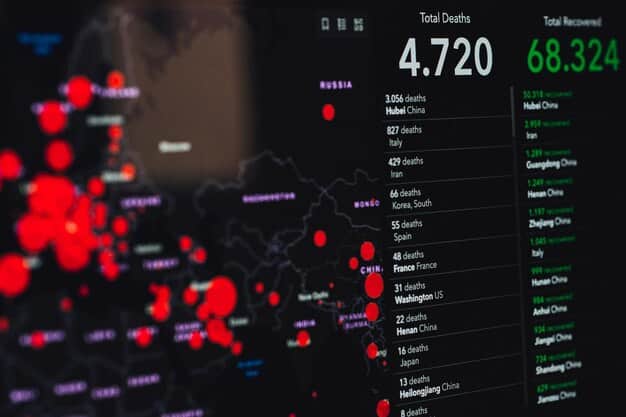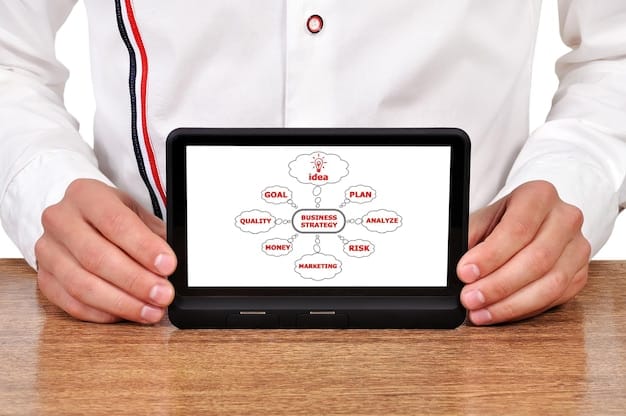Cybersecurity Guide: Top 5 EDR Solutions for 2025

Discover the top 5 Endpoint Detection and Response (EDR) solutions for 2025, comparing their features, effectiveness, and suitability for different business needs to enhance your cybersecurity posture.
Protecting your digital assets is paramount in today’s evolving threat landscape. The **Cybersecurity Guide: Top 5 Endpoint Detection and Response (EDR) Solutions Compared for 2025** offers insights to help businesses choose the right tools.
Understanding Endpoint Detection and Response (EDR)
Endpoint Detection and Response (EDR) represents a critical advancement in cybersecurity, shifting beyond simple prevention to focus on detecting and responding to threats that bypass initial defenses. EDR solutions continuously monitor endpoints for suspicious activities, providing detailed analytics and actionable insights to security teams.
The Core Functions of EDR
At its core, an EDR system performs several key functions, including:
- Continuous Monitoring: Real-time tracking of endpoint activities to identify anomalies and potential threats.
- Data Analysis: Advanced analytics and machine learning algorithms to analyze collected data and detect suspicious patterns.
- Threat Detection: Identifying and alerting security teams to potential security breaches and malicious activities.
- Incident Response: Providing tools and capabilities to investigate and respond to detected incidents, including isolating affected endpoints and eradicating threats.
Why EDR is Essential for Modern Cybersecurity
With the increasing sophistication of cyber threats, relying solely on traditional security measures like antivirus software and firewalls is no longer sufficient. EDR provides an enhanced layer of security by:
- Addressing Advanced Threats: Detecting and responding to advanced persistent threats (APTs), ransomware, and other sophisticated attacks.
- Improving Incident Response: Shortening the time to detect and respond to security incidents, minimizing potential damage.
- Providing Visibility: Offering comprehensive visibility into endpoint activities, enabling security teams to understand the scope and impact of security incidents.
In summary, EDR systems offer a crucial defense against modern cyber threats by providing continuous monitoring, advanced data analysis, and rapid incident response capabilities.
Key Features to Look for in an EDR Solution
When selecting an EDR solution, it’s crucial to consider several key features that will determine its effectiveness and suitability for your organization’s specific needs. These features include real-time monitoring, behavioral analysis, automated response, threat intelligence integration, and ease of use.

Real-Time Monitoring and Visibility
Real-time monitoring is the backbone of any effective EDR solution. It involves continuously tracking endpoint activities, including process executions, network connections, and file modifications. This provides security teams with comprehensive visibility into what’s happening on each endpoint.
A robust EDR solution should:
- Provide real-time data on endpoint activities.
- Offer granular visibility into processes, network connections, and file modifications.
- Enable security teams to quickly identify and investigate suspicious activities.
Behavioral Analysis and Anomaly Detection
Behavioral analysis is another critical feature, utilizing machine learning and advanced analytics to identify anomalous behaviors that could indicate a security threat. By establishing a baseline of normal endpoint behavior, the EDR solution can detect deviations that warrant further investigation.
An effective behavioral analysis capability should:
- Use machine learning to establish a baseline of normal behavior.
- Detect deviations from the baseline that could indicate a security threat.
- Reduce false positives by accurately identifying malicious activities.
In conclusion, real-time monitoring and behavioral analysis are essential for detecting and responding to today’s sophisticated cyber threats. These features provide the visibility and insights needed to protect your organization’s endpoints.
Top 5 EDR Solutions for 2025: A Detailed Comparison
With numerous EDR solutions available in the market, selecting the right one for your organization can be a daunting task. Here’s a detailed comparison of the top 5 EDR solutions expected to lead the market in 2025, highlighting their strengths, weaknesses, and unique features.
Solution 1: CrowdStrike Falcon
CrowdStrike Falcon is renowned for its cloud-native architecture and comprehensive endpoint protection. It offers real-time threat detection, incident response, and threat intelligence, making it a top choice for organizations of all sizes. CrowdStrike Falcon is a leader in threat intelligence integration, providing proactive defense against emerging threats.
Solution 2: SentinelOne Singularity
SentinelOne Singularity stands out with its autonomous endpoint protection capabilities, leveraging AI and machine learning to detect and respond to threats in real-time without human intervention. This makes it an ideal solution for organizations seeking to automate their security operations. SentinelOne excels in its ability to autonomously respond to threats, minimizing the need for manual intervention.
Solution 3: Microsoft Defender for Endpoint
Microsoft Defender for Endpoint offers robust endpoint protection with seamless integration with other Microsoft security solutions. It provides advanced threat analytics, automated investigation, and remediation capabilities, making it a strong contender for organizations heavily invested in the Microsoft ecosystem. Microsoft Defender offers seamless integration with other Microsoft security solutions.
Solution 4: VMware Carbon Black Cloud
VMware Carbon Black Cloud is a comprehensive endpoint security platform that offers advanced threat detection, prevention, and response capabilities. It leverages behavioral analytics and machine learning to identify and stop threats in real-time. VMware Carbon Black Cloud is particularly strong in threat prevention, stopping threats before they can cause damage.
Solution 5: Trend Micro Apex One
Trend Micro Apex One provides a broad range of endpoint protection capabilities, including threat detection, prevention, and response. It offers a centralized management console and integrates with other Trend Micro security solutions, making it a good option for organizations seeking a unified security platform. Trend Micro Apex One excels in proactive threat prevention and centralized management.
In conclusion, each of these EDR solutions offers unique strengths and capabilities. Selecting the right one depends on your organization’s specific needs, budget, and existing security infrastructure.
Evaluating EDR Solutions: Key Criteria
Evaluating EDR solutions requires a comprehensive approach that considers various criteria, including detection accuracy, response capabilities, integration with existing security tools, ease of deployment and management, and cost. These criteria will help you narrow down your options and select the EDR solution that best fits your organization’s needs.

Detection Accuracy and Effectiveness
- Assess the solution’s ability to accurately detect a wide range of threats with minimal false positives.
- Evaluate its effectiveness in identifying advanced threats, such as APTs and zero-day exploits.
- Consider independent test results and industry benchmarks to validate its detection capabilities.
Response Capabilities and Automation
Evaluate the solution’s ability to quickly and effectively respond to detected threats. Look for features such as:
- Automated incident response workflows.
- Endpoint isolation and containment.
- Threat eradication and remediation tools.
Integration with Existing Security Tools
Assess the solution’s ability to integrate with your existing security tools and infrastructure. Consider the following:
- Compatibility with your existing SIEM, firewalls, and other security solutions.
- Integration with threat intelligence feeds and platforms.
- APIs and integration capabilities for custom integrations.
By evaluating EDR solutions based on these criteria, you can make an informed decision and select the solution that best meets your organization’s unique needs and requirements.
Implementing and Managing EDR Solutions
Implementing and managing EDR solutions effectively requires careful planning, execution, and ongoing monitoring. A well-defined implementation strategy, coupled with proactive management practices, will ensure that your EDR solution delivers maximum value and protection.
Planning and Preparation
Before deploying an EDR solution, it’s crucial to:
- Define your organization’s security goals and objectives.
- Identify your critical assets and endpoints that require protection.
- Develop a detailed implementation plan that outlines the scope, timeline, and resources required.
Deployment and Configuration
The deployment process should be carefully managed to minimize disruption to your organization’s operations. Key steps include:
- Rolling out the EDR agent to all endpoints.
- Configuring the solution based on your organization’s specific security policies and requirements.
- Integrating the EDR solution with your existing security infrastructure.
Ongoing Monitoring and Management
Once the EDR solution is deployed, ongoing monitoring and management are essential to ensure its effectiveness. This includes:
- Regularly reviewing and analyzing threat alerts and incidents.
- Updating the solution with the latest threat intelligence and security patches.
- Continuously monitoring the performance and health of the EDR system.
By following these best practices, you can ensure that your EDR solution is effectively protecting your organization’s endpoints and contributing to a stronger overall security posture.
| Key Point | Brief Description |
|---|---|
| 🛡️ Real-Time Monitoring | Continuous tracking of endpoint activities to detect anomalies. |
| 🤖 Automated Response | Automated workflows for quick incident response. |
| 📊 Threat Intelligence | Integration with threat intelligence feeds for proactive defense. |
| ⚙️ Integration | Seamless integration with existing security tools. |
Frequently Asked Questions (FAQ)
▼
The primary function of an EDR solution is to continuously monitor endpoints for suspicious activities, providing detailed analytics and actionable insights to security teams for rapid incident response.
▼
Behavioral analysis establishes a baseline of normal endpoint behavior using machine learning, detecting deviations that indicate potential security threats, thus improving the accuracy of threat detection.
▼
Real-time monitoring provides comprehensive visibility into endpoint activities, allowing security teams to quickly identify and investigate suspicious activities as they occur, reducing the time to detect and respond.
▼
When evaluating EDR solutions, consider detection accuracy, response capabilities, integration with existing security tools, ease of deployment and management, and cost to ensure it meets your organization’s needs.
▼
Effective EDR implementation involves careful planning, defining security goals, deploying the solution, configuring it based on security policies, and continuously monitoring the system for optimal protection.
Conclusion
In conclusion, selecting and implementing the right Endpoint Detection and Response (EDR) solution is crucial for enhancing your organization’s cybersecurity posture. By understanding the key features, evaluating available solutions, and following best practices for implementation and management, you can effectively protect your endpoints from advanced threats in 2025 and beyond.





